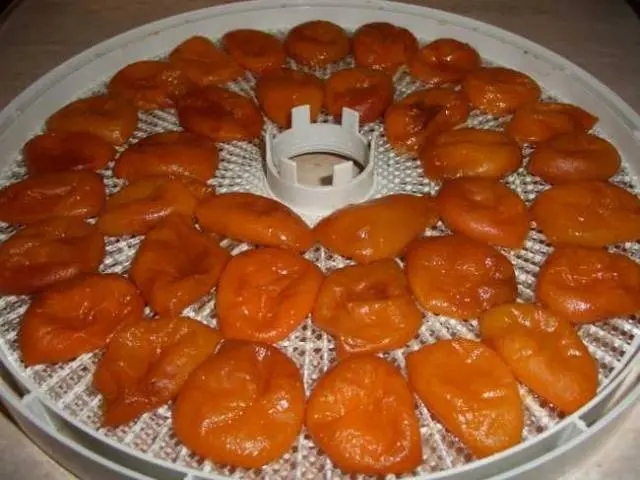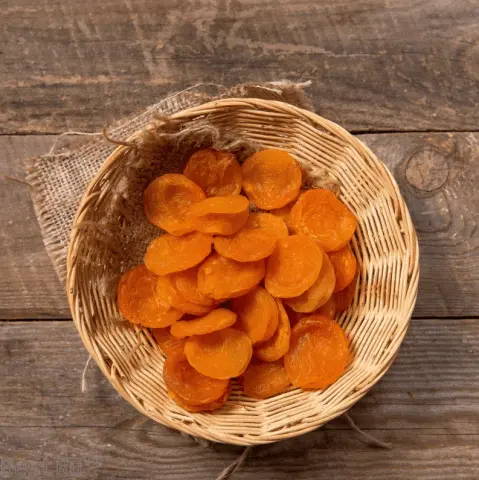Contents
Apricots are a source of vitamins and other useful substances. You can save their properties by drying their pulp. First, high-quality fruits are selected, which are cleaned of dirt and seeds. You can dry apricots in natural conditions or with the help of kitchen appliances.
How to choose and prepare
Before starting work, it is important to know how dried apricots differ from dried apricots. If small fruits with seeds are dried, the result is apricots. Large fruits in which bones are left are called whispers. Dried pitted fruit is kaisa.
When choosing apricots for drying, the crop variety matters. To obtain dried apricots, large fruits with a minimum juice content are suitable. Such fruits are distinguished by dense pulp and a high concentration of sugar.
To obtain dried apricots, varieties grown in Central Asia with a sugar content of more than 20% are chosen. If apricots are grown in the middle lane or in the south, then you need to find specimens of varieties containing 10% sugar or more.
For drying, choose ripe fruits without traces of decay and other damage. Fruits are washed well so as not to expose them to moisture in the future. Then they are divided into halves, the bones are removed.
Under industrial conditions, apricots are treated with sulfur dioxide. The procedure ensures the presentation of dried apricots.
To preserve the bright orange color of dried apricots, pre-treatment of fresh fruits will help:
- Apricot halves are placed in a colander.
- For 5-10 minutes, the colander is held over the steam. If the apricots have a hard skin, then they are boiled for 5 minutes.
- The fruits are laid out on a piece of cloth that will absorb excess moisture.
- After 2-3 hours, the fruit is ready for drying.
Another way to preserve the vibrant color of the fruit is to use citric acid. For 1 liter of water add 1 tsp. citric acid. The fruits are placed in the solution for 1-2 hours.

How to dry apricots in an electric dryer
To dry fruits at home, you can use a special device – an electric dryer. Its design includes a large container in which several trays are located. Fruits are laid out on them for drying.
The electric dryer operates in one or more temperature modes, depending on the model of the device. When choosing an electric dryer, its capacity, the number of pallets and power are taken into account.
Drying occurs under the influence of infrared radiation or by heating the air. When using infrared heaters, the beneficial properties of apricots are preserved. In this case, the fruit is cut into small pieces.
In devices with heating elements, fruits lose some of their vitamins and change their color. Such devices are suitable for drying large fruits.
The procedure for processing apricots in an electric dryer:
- The fruits are washed and prepared for the drying process.
- Halves of the fruit are laid out on pallets in one layer.
- Trays are installed in an electric dryer.
- The device is turned on 50 degrees.
- Pallets are swapped every hour. In the middle of the process, the temperature is raised to 60 degrees.
- After 8-12 hours, the apricots are taken out of the dryer. The processing period depends on the quality and variety of the fruit.
- Dried apricots are transferred to a box or a wooden box. For 3-4 weeks they are placed in a cool place to complete the drying process. As a result, moisture will be redistributed in the pulp.

Outdoor drying
In warm climates, apricots dry well in natural conditions in the fresh air. Successful drying requires high temperature and low humidity. It is best to leave the fruit in direct sunlight.
In urban areas, it is important to protect dried apricots from pollution. It is not recommended to start drying near highways or operating enterprises.
How to dry apricots outdoors:
- Prepared fruits are laid out on a wire rack and covered with gauze to protect against insects and dirt.
- The grate is left in a dark, ventilated place.
- Within 6 hours, the pulp will begin to dry out and the fruit will wilt.
- Then the fruits are transferred to a place well lit by the sun.
- Dried apricots are kept until completely dry, then put away for storage.
To check the readiness of fruits, evaluate their consistency and condition. The fruits must be taken in hand and squeezed a little. If no juice is released, and the pulp remains elastic and soft, then it’s time to remove the dried apricots for permanent storage.
The period of drying dried apricots in the open air depends on their quality and size, as well as on weather conditions. On average, this process takes 1 to 2 weeks. In windy weather, the fruits dry out faster.
It is convenient to dry apricots in limbo. The fruits are strung on a thread or a thin rope, which is fixed in a horizontal position. In this way, dense fruits with a low juice content are dried. Soft fruits are strung on wooden twigs or skewers.

Drying apricots in the oven
In urban areas, it is easier to dry apricots in a gas or electric oven.
The drying process with an oven includes several stages:
- The trays are lined with parchment paper.
- Halves of apricots are laid on top so that the cut is at the top.
- The oven is turned on at 50 degrees.
- The trays are transferred to the oven.
- Leave the door ajar to allow air to enter. If you close the oven, the apricots will bake.
- After 10 hours, dried apricots are taken out of the oven and sent for storage.
Drying in the microwave
Using the microwave is not the best way to dry apricots. During the drying period, it is important to provide the fruits with air. If this is not done, then as a result you can get boiled fruits.
If there are no other options for drying, you can put fresh fruit in the microwave and turn it on for 2 minutes. Then the fruits are removed from the device. The procedure is repeated several times until the desired result is achieved. This method does not ensure complete drying of the apricots.
How to store
Dried apricots are stored under certain conditions:
- humidity no more than 70%;
- lack of direct sunlight;
- temperature from 10 to 20 degrees.
It is best to keep dried apricots at home: in the kitchen cabinet, along with cereals and other products. The refrigerator (compartment for vegetables) is well suited for storage.

Dried apricots are transferred to a glass or plastic jar and closed with a tight lid. At room conditions, it is not recommended to store dried apricots in plastic bags.
Shelf life of dried apricots is from 3 to 4 months. Dried fruits are stored in the freezer for up to a year and a half. Dried apricots are thawed gradually at room temperature. After freezing, the fruits will partially lose their beneficial properties.
Dried apricots are a source of nutrients. For drying, choose ripe fruits of sweet varieties that do not have defects. Apricots can be left to dry naturally. Using an electric dryer or oven will help speed up the process.









